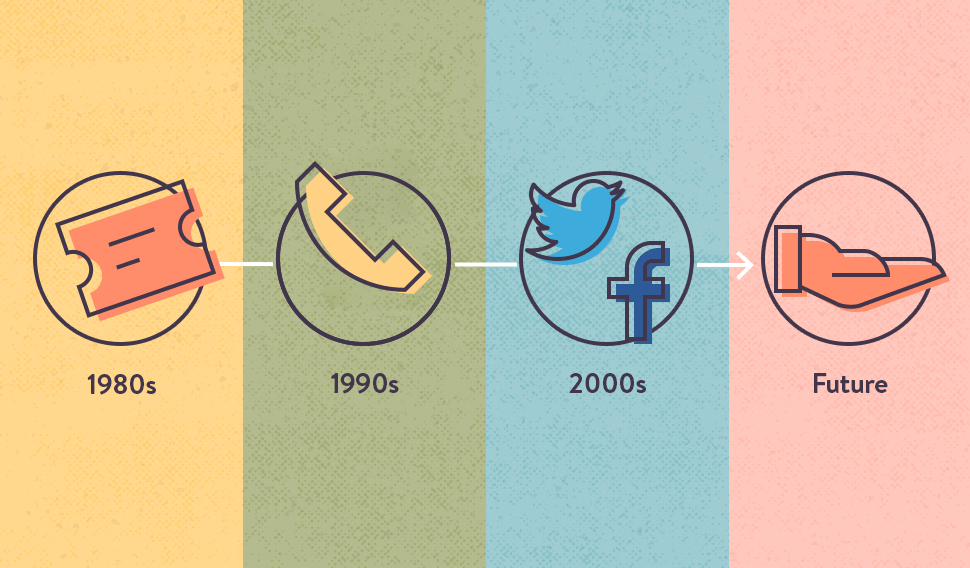The Evolution of Ticket Systems: From Box Offices to Advanced Virtual Assistants

August 13, 2024
Ticket systems have come a long way from their humble beginnings, evolving into sophisticated platforms with advanced functionalities. These ticket system platforms serve as virtual assistants with intuitive interfaces, marketing tools, and specialist teams, revolutionizing the ticketing process. The journey of ticket systems reflects the technological advancements over the decades, marked by five distinct generations.
First Generation: The 1990s
Example: Computer Ticket System “Basis”
In the 1990s, the first generation of ticket systems emerged alongside the rise of personal computers and local networks. These systems were designed for offline ticket sales at box offices, focusing on processing applications manually. Development tools such as Borland Delphi were commonly used, and the systems lacked open architecture principles, making it difficult to update or replace components easily. Online ticket purchasing was virtually non-existent during this era, and the systems were primarily used by venue staff rather than ticket buyers.
The architecture of these systems was relatively simple, relying on local databases and standalone applications installed on desktop computers. They provided basic functionalities such as ticket reservation, seat allocation, and sales reporting. Despite their limitations, these systems marked a significant step forward from the manual, paper-based methods previously used for ticket sales.

Second Generation: The 2000s
Example: TicketSoft System
The second generation saw ticket systems being installed locally at event venues like theaters, concert halls, and stadiums, as well as in city ticket offices. Due to unreliable and low-bandwidth internet channels, these systems operated on local networks. They integrated with Access Control Systems (ACS) and were mainly used by venue employees. While the majority of sales still occurred through box offices, the introduction of websites began to offer an alternative channel for ticket sales.
These systems were more advanced than their predecessors, featuring improved user interfaces and better integration with other venue management systems. However, their reliance on local networks and on-premises installations meant that they were still relatively inflexible and difficult to scale. Internet sales were limited by the technology of the time, and the primary focus remained on offline sales channels.
Third Generation: Early 2010s
Examples: Ticketscloud, Radario, Intickets, Unified Field
The early 2010s marked the advent of third-generation ticket systems, which were web platforms implementing a platform business model. These platforms introduced various user roles, such as event organizers, ticket agents, and buyers. With the improvement in internet reliability and speed, these platforms shifted from object-based solutions to cloud-based solutions, significantly reducing offline sales. APIs and gateways allowed for competitive ticket sales by multiple agents in real time, and online marketing and SEO tools became integral features of these platforms.
Third-generation systems represented a major shift in how tickets were sold and managed. By moving to the cloud, these platforms could offer much greater flexibility and scalability. They also enabled real-time collaboration between different stakeholders, such as event organizers, venue managers, and ticket agents. This generation of systems also introduced more sophisticated marketing tools, allowing organizers to better promote their events and reach a wider audience.

Fourth Generation: Late 2010s
Example: BIL24
Fourth-generation ticket systems were built using modern software development tools and technologies like industrial NOSQL DBMSs. These platforms were designed to handle high loads with fast, reliable multi-threaded processing. They featured numerous two-way gateways for integration with other ticket systems, allowing organizers and agents to use their own internet acquiring services. The focus was on providing a seamless experience with robust performance and reliability.
One of the key innovations of fourth-generation systems was their ability to handle large volumes of transactions and data in real-time. This was essential for managing high-demand events, such as major concerts or sports games, where tickets could sell out in minutes. These systems also offered more advanced analytics and reporting tools, helping organizers to make better-informed decisions about pricing, marketing, and event management.
Fifth Generation: The 2020s
The fifth generation of ticket systems is currently under development, but their distinctive features are already apparent. These platforms offer real-time updates of seat statuses on hall and stadium diagrams without requiring a full reload, known as “live diagrams.” They include built-in no-code website designers and applications, simplifying and reducing the cost of putting events on sale. Integrations with external systems such as CRM, online accounting, and analytics are becoming more sophisticated. The ecosystem is expanding to include new user roles like insurance companies and sellers of event-related goods and services. Tools for package offers are also being developed, enhancing the overall user experience.
Fifth-generation systems are designed to be highly modular and adaptable, allowing them to integrate seamlessly with a wide range of other business systems. This makes them ideal for complex, multi-faceted events that involve numerous stakeholders and require detailed coordination. These platforms are also focused on enhancing the user experience, both for event organizers and ticket buyers, with features like personalized recommendations, dynamic pricing, and advanced security measures.

The Impact of Ticket Systems
Ticket systems have profoundly impacted the event industry, streamlining operations and improving the overall experience for organizers and attendees alike. By automating many of the administrative tasks associated with ticket sales, these systems have allowed event organizers to focus more on creating memorable experiences for their audiences.
For ticket buyers, the evolution of ticket systems has made purchasing tickets easier and more convenient than ever before. From the early days of standing in line at box offices to the current ability to buy tickets instantly from a smartphone, these systems have continually enhanced the customer experience. Features like mobile ticketing, digital wallets, and instant seat selection have made the process faster, more secure, and more enjoyable.
Future Trends in Ticket Systems
As technology continues to evolve, ticket systems are likely to become even more advanced and integrated. Some potential future trends include:
- Artificial Intelligence (AI) and Machine Learning (ML): These technologies could be used to provide more personalized recommendations to ticket buyers, optimize pricing strategies, and improve fraud detection.
- Blockchain: Blockchain technology could offer a more secure and transparent way to manage ticket sales and prevent issues like scalping and counterfeit tickets.
- Virtual and Augmented Reality (VR/AR): VR and AR could be used to enhance the ticket buying experience, allowing customers to virtually explore venues and choose their seats.
- Sustainability: As environmental concerns become more pressing, ticket systems may incorporate more eco-friendly practices, such as digital-only tickets and carbon offset programs.
Conclusion
Today, ticket systems are ubiquitous, streamlining the ticket purchasing process and saving users time. From their inception in the 1990s to the advanced platforms of the 2020s, ticket systems have continuously evolved to meet the changing demands of the market and technological advancements. These systems have transformed the ticketing industry, making it more efficient, accessible, and user-friendly. As we look to the future, ticket systems will likely continue to innovate and adapt, further enhancing the way we buy and sell tickets for events around the world.

Basketball fan, coffee addict, record lover, International Swiss style practitioner and ADC member. Working at the intersection of modernism and elegance to craft experiences that go beyond design. Currently living in New York City.





